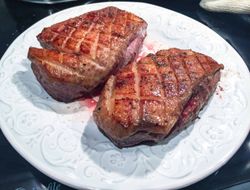While plum sauce is most commonly associated with Chinese duck dishes, canard à l’orange is arguably the most popular Western European duck breast recipe. Although most typically associated with French cuisine, the dish is actually alleged to originate in Florence, Italy.
Originally known as ‘papero alla melarancia’, what’s now known as canard à l’orange (duck with orange) is said to have been invented in Florence during the Middle Ages, when pairing meat with fruit became popular, and citrus fruits were utilised as a means of preserving meat. When Caterina de’ Medici, daughter of Lorenzo II de’ Medici, ruler of Florence, married future king of France, Henry II, the dish is said to have been exported to France. Caterina de’ Medici was accompanied by forty chefs from Siena and Florence when she moved to Paris in the 1520s, bringing some of their best recipes, many of which were later claimed by the French.
Eaten in many cuisines around the word, duck is high in protein and iron, but also in fat, which deters some people from cooking the bird at home, with a general consensus that suggests duck is difficult to cook well. The fact that duck breast can be served pink, like most red meats, actually makes it far more forgiving than most poultry; and when the thick layer of subcutaneous fat (for insulation) is rendered properly, it’s absolutely delicious. In addition to the breasts, confit duck legs are a wonder of the culinary world, the liver is commonly used for foie gras, in place of goose, and the fat is amongst some of the world’s most cherished for cooking.
To get it right every time, the perfect duck breast recipe calls for a cold pan, wide enough to contain the breasts with space around them. Cooking over low heat, in a pan that hasn’t been pre-warmed, helps the fat to render properly, ultimately encouraging the skin to become crisp. I also dry the duck breasts with paper towels and leave them to air in the fridge for a couple of hours, cooking them from chilled rather than bringing them to room temperature, as with steak.
Scoring a cross-hatch on the skin and seasoning generously is also essential here, providing the cuts are fairly shallow so not to expose the flesh. This increases the surface area of the fat, helping it to render quickly, with more exposure to the heat of the pan. After slowly cooking the breasts skin-side-down for around 15 minutes, the flesh requires very little cooking time for a medium rare duck breast (which is recommended), with an internal temperature registering at around 120-130F. Like steak, the duck breast can – of course – be cooked well-done, but much of the flesh’s softness will be lost, with the bird quickly dehydrating and becoming chewy. If you don’t have a meat thermometer to hand, you can test the doneness by pressing it with your finger. It should be firm, yet springy.
A versatile meat that’s suited to numerous dishes, this duck breast recipe pairs the bird with a simple plum sauce, more akin to a loose jam than plum sauce typically used in Chinese cooking. I find the sweet-sharpness of the plums works particularly well with the richness of the duck breast. Serve with thin slices of potato with garlic, cooked in duck fat; dark green vegetables; or whatever you fancy. Just don’t forget to reserve the strained fat in a glass jar – it’ll keep for a good few weeks in the fridge.

Duck breast with plum sauce
Ingredients
- 2 duck breasts
- Salt
- Freshly ground black pepper
- 400 g plums halved and stoned
- 50 g demerara sugar
- 200 ml red wine
- 1 cinnamon stick
- 50 g unsalted butter
Instructions
- To prepare the duck breasts, score the skin with a cross hatch pattern, being careful to avoid cutting deep enough to expose the flesh. Generously season the skin and place in the fridge, skin-side-up, for 30 minutes – 2 hours to dry.
- To prepare the plum sauce, add the halved, stoned plums to a medium saucepan with the sugar, red wine, butter, the cinnamon stick, and a pinch of salt. Slowly bring to the boil then simmer uncovered for around 20 minutes, until the plums are soft. Stir occasionally to prevent the plums from sticking.
- Place the duck breasts in a cold pan, skin-side-down, and cook over low heat, using a smaller pan or weight to press the duck breasts, exposing more of the skin to the heat. Cook slowly until the fat renders and the skin begins to crisp. This should take around 15 – 20 minutes, depending on the size of the duck breasts. At this point, increase the heat and cook for another 2-3 minutes until the skin is golden brown and crispy.
- Turn the breasts over and cook over a medium heat until the flesh is seared, and the internal temperature reaches 120-130F for medium-rare. This will only take up to five minutes. Cook to 155F if you prefer your duck breasts well-done.
- Remove the duck from the pan and rest for 15 minutes before slicing. Strain and reserve the fat in a glass jar with a lid. It’ll keep in the fridge for a few good few weeks.

